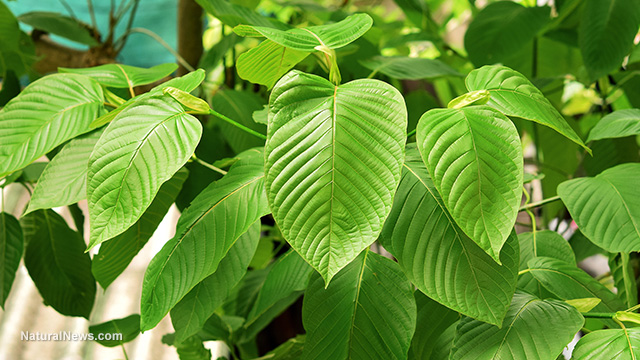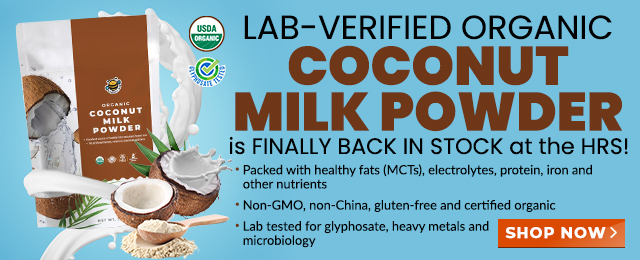What you need to know about the government's war on cannabis and kratom
Tuesday, October 11, 2016 by: Samantha Debbie
Tags: cannabis, kratom, DEA

(NaturalNews) Humans have been using medical cannabis to treat a vast array of ailments for thousands of years. Physicians in the United States used it as far back as the 1800s, at which time they were allowed to operate independently, free from government regulation. At that time, cannabis was one of their most commonly used medicines.
Even the pharmaceutical industry utilized cannabis medicinally. By 1850, many pharmaceutical companies were using cannabis for a large variety of illnesses, including cholera, rabies, alcoholism, opiate addiction, typhus, leprosy, insanity, tonsillitis, excessive menstrual bleeding and many others.
But once drugs like aspirin and morphine proved to be more lucrative, the demonization of cannabis soon followed. After the U.S. Food and Drugs Act was passed in 1906, access to cannabis slowly began slipping away.
By 1936, nearly all U.S. states had enacted laws restricting cannabis, some of which are still in effect today.
Federal government refuses to acknowledge the many health benefits of cannabis
While a new and more accepting attitude surrounds the use of the plant today, the federal government continues to ignore its medicinal benefits. This is despite mounds of research showing that the plant is useful for humans in combating cancer, reducing and/or eliminating seizures, managing pain and inflammation, and treating neurodegenerative disorders such as Parkinson's disease and Alzheimer's.In early August, the Drug Enforcement Agency (DEA) rejected attempts made by two Democratic governors to ease restrictions on marijuana. The agency stood firm on its current classification for the plant, keeping it as a schedule I drug.
Schedule I drugs include substances or chemicals considered to have no "currently accepted medical use," and "a high potential for abuse," according to the DEA. Other drugs in this category include heroin, LSD, ecstasy and peyote. Even cocaine and opium, Schedule II drugs, have a lower classification than marijuana.
Now, the feds are going after kratom, a plant used for treating pain. On August 30, the DEA announced that it wants to classify the plant as a Schedule I substance.
The Daily Sheeple reports:
"The Drug Enforcement Administration (DEA) today announced its intention to place the active materials in the kratom plant into Schedule I of the Controlled Substances Act in order to avoid an imminent hazard to public safety.
"Kratom is abused for its ability to produce opioid-like effects and is often marketed as a legal alternative to controlled substances.
"In addition, kratom has a high potential for abuse, has no currently accepted medical use in treatment in the United States, and has a lack of accepted safety for use under medical supervision. DEA is aware of 15 kratom-related deaths between 2014 and 2016."
DEA goes after plant that treats pain naturally; announces plan to label it a schedule 1 drug
The problem with the agency's statement is that 15 deaths are hardly comparable to the hundreds of thousands of deaths caused by prescription drugs, which are in fact also addictive.Since January 1, 2000, prescription drugs have killed roughly 381,000 people in the United States, and opioids alone are responsible for the death of 271,617 people. Antidepressant overdoses have killed 65,000, while anti-psychotic and neuroleptic drugs have led to the deaths of 22,600.
"[T]he DEA's claim that deaths have been linked to the plant is dubious: Most deaths associated with kratom have occurred in people who reportedly tested positive for numerous substances or were suffering from pre-existing medical conditions. Users report that consuming too much kratom will only lead to nausea and vomiting, which can prevent overdose," reports The Daily Sheeple.
"The DEA's claim that it intends to ban on kratom to 'avoid an imminent hazard to public safety' is odd, considering the plant is not widely used as a recreational drug: It is mainly used by people who are trying to manage pain, alleviate depression, and overcome opioid addiction."
"Kratom is a natural botanical native to tropical Southeast Asia that is part of the coffee family. It's also known by its scientific name, Mitragyna speciosa. The people of Southeast Asia have used Kratom leaves as an herbal supplement and traditional remedy for hundreds of years," according to the website of the American Kratom Association.
"The plant is a natural analgesic which is used to safely alleviate pain, combat fatigue, and help with the effects of anxiety and depression."
Sources:
TheDailySheeple.com
NewsTarget.com
NaturalNews.com
NewsTarget.com
PharmaDeathClock.com
Cannabis at FETCH.news
Get independent news alerts on natural cures, food lab tests, cannabis medicine, science, robotics, drones, privacy and more.
Take Action: Support Natural News by linking to this article from your website
Permalink to this article:
Embed article link: (copy HTML code below):
Reprinting this article:
Non-commercial use OK, cite NaturalNews.com with clickable link.
Follow Natural News on Facebook, Twitter, Google Plus, and Pinterest
- Aerosolized bioweapons? Strange “diploid biomasses” falling out of the sky in Florida captured under the microscope
- Israeli lobbyists boast of controlling US national security policy in leaked AIPAC audio
- Widespread social and economic unrest: Steve Quayle issues urgent financial warning of imminent asset collapse in new interview with Mike Adams
- Analysis: The coming economic collapse, a mass uprising and Trump's three secret weapons to halt the growing revolt
- U.S. lawmakers investigate Meta over alleged China collaboration
- Fauci is back in the limelight, and he’s busy promoting a future COVID or FLU pandemic
- Kiss Your Genetic Privacy Good-Bye! 23andMe Gets Green Light to Sell Your Intimate Genetic Details to Anyone They Want
- Mike Adams releases country western hit single: Goin’ Back in Time is Comin’ Home
- Warp Speed 2.0: Trump Administration ACCELERATES Gates-funded, self-amplifying bird flu vaccines
- TAKE IT DOWN Act advances in Congress amid free speech concerns
- DMSO and Natural Dyes: A suppressed cancer treatment resurfaces in independent research
- CLOT SHOT PLANDEMIC UNFOLDING: Fibrous, rubbery clots caused by covid injections have prion-like seeding activity
- Tulsi Gabbard leads charge against the Biden regime’s global censorship of the 'Disinformation Dozen'
- Father speaks out: Challenging the mainstream narrative of his daughter’s “unvaccinated measles death”
- Defunding DEADLY mRNA jabs: Government funding for mRNA technology being scrutinized and sidelined until proven "safe and effective" for real
- Chemical cocktails in processed foods linked to diabetes, validating natural health warnings
- Curcumin’s ancient healing power supercharges muscle recovery, and its effects are compounded with anti-inflammatory foods and supplements
- 6 Seemingly safe US states you should avoid when SHTF
- Aerosolized bioweapons? Strange “diploid biomasses” falling out of the sky in Florida captured under the microscope
- Fauci is back in the limelight, and he’s busy promoting a future COVID or FLU pandemic
- Tulsi Gabbard leads charge against the Biden regime’s global censorship of the 'Disinformation Dozen'
- Analysis: The coming economic collapse, a mass uprising and Trump's three secret weapons to halt the growing revolt
- Widespread social and economic unrest: Steve Quayle issues urgent financial warning of imminent asset collapse in new interview with Mike Adams
- Kiss Your Genetic Privacy Good-Bye! 23andMe Gets Green Light to Sell Your Intimate Genetic Details to Anyone They Want
- U.S. lawmakers investigate Meta over alleged China collaboration
- Mike Adams releases country western hit single: Goin’ Back in Time is Comin’ Home
- Israeli lobbyists boast of controlling US national security policy in leaked AIPAC audio
- Chemtrails unveiled: How the CIA and Big Business are manipulating the weather for profit
- Curcumin’s ancient healing power supercharges muscle recovery, and its effects are compounded with anti-inflammatory foods and supplements
- CLOT SHOT PLANDEMIC UNFOLDING: Fibrous, rubbery clots caused by covid injections have prion-like seeding activity
- China’s counter-tariff strategies: A new chapter in the U.S.-China trade war
- Pfizer's RSV vaccine linked to preterm births as drug giant CONCEALED RISKS from pregnant women in unethical clinical trials
- Shedding light on the dark side of MMR vaccines: How vaccinated individuals SPREAD MEASLES & put the vulnerable at risk
- Dane Wigington exposes climate engineering as ‘All-Out Weather and Biological Warfare’
- Defunding DEADLY mRNA jabs: Government funding for mRNA technology being scrutinized and sidelined until proven "safe and effective" for real
- DEATH by VACCINE or face PRISON time: Canadian Freedom Convoy leaders CONVICTED for protesting forced vaccination during the Covid Plandemic
- Newly released JFK files reveal Pentagon's role in creating Lyme disease and covid in the same lab
- Analysis: The coming economic collapse, a mass uprising and Trump's three secret weapons to halt the growing revolt
- Mike Adams releases country western hit single: Goin’ Back in Time is Comin’ Home
- Aerosolized bioweapons? Strange “diploid biomasses” falling out of the sky in Florida captured under the microscope
- Kiss Your Genetic Privacy Good-Bye! 23andMe Gets Green Light to Sell Your Intimate Genetic Details to Anyone They Want
- European Court of Justice: Healthcare professionals who promoted or administered COVID-19 vaccines are CRIMINALLY LIABLE for any harm caused
- Federal employees whine over DOGE's new directive requiring them to do a 5-point summary of weekly accomplishments
- U.S. approves new Russian ambassador as diplomatic thaw continues
- Government waste exposed: Hegseth supports Musk’s demand for accountability from federal workers
- Now you can HEAR chemistry: Health Ranger translates molecules into music in stunning video demonstration that will blow your mind (and your ears)
- Widespread social and economic unrest: Steve Quayle issues urgent financial warning of imminent asset collapse in new interview with Mike Adams
- Dr. Mike Yeadon releases 15-minute testimony - WATCH - about genocidal intent of COVID “vaccines”
- The Health Ranger releases “Vaccine Zombie” song and music video, using AI-animated zombies for the music video
- Trump reverses course on Gaza plan, says “nobody is expelling Palestinians”
- EPA advisor admits the agency is funneling billions to climate groups ahead of Trump’s return to White House
- 5 Simple steps to boost your brainpower: How to strengthen executive function in a distracted world
- I Want My Bailout Money – new song and music video released by Mike Adams
- Tulsi Gabbard leads charge against the Biden regime’s global censorship of the 'Disinformation Dozen'
- Red Cross issues warning to stop blood plasma donations from vaccinated people
- Scientists confirm: GENIUS brain function can be spontaneously unleashed in humans without any apparent cause
- EPA advisor admits the agency is funneling billions to climate groups ahead of Trump’s return to White House
- HYSSOP: What research reveals about the health benefits of this ancient holy herb
- Two containers with completed ballots fall out of truck in Florida
- Newly released JFK files reveal Pentagon's role in creating Lyme disease and covid in the same lab
- Global leaders unite to clamp down on “misinformation” with UN-backed Cascais Declaration
- BREAKING: 2025 NDAA authorizes mandatory military draft of WOMEN across America… as Pentagon pursues global NUCLEAR war with both Russia and China at the same time
- Mike Adams releases country western hit single: Goin’ Back in Time is Comin’ Home
- Michael Yon warns of a ZIONIST TAKEOVER in Trump’s second administration
- Ozempic and Wegovy weight loss drugs are injectable LIZARD VENOM PEPTIDES that may unleash a devastating wave of organ failure… side effects align with symptoms of SNAKE BITES
- The Health Ranger releases “Vaccine Zombie” song and music video, using AI-animated zombies for the music video
- BOMBSHELL: DNA testing kits are a SCAM to develop ethnic-specific bioweapons
- Israeli soldiers accused of even more torture and abuse in the West Bank
- These 13 countries just signed an agreement to engineer a global FAMINE by destroying food supply
- I Want My Bailout Money – new song released by Mike Adams
- NASA admits that climate change occurs because of changes in Earth’s solar orbit, and NOT because of SUVs and fossil fuels
- RFK Jr. clears key hurdle: Sen. Susan Collins backs controversial HHS nominee, signaling a new era for health policy
Science News & Studies
Medicine News and Information
Food News & Studies
Health News & Studies
Herbs News & Information
Pollution News & Studies
Cancer News & Studies
Climate News & Studies
Survival News & Information
Gear News & Information
News covering technology, stocks, hackers, and more



"Big Tech and mainstream media are constantly trying to silence the independent voices that dare to bring you the truth about toxic food ingredients, dangerous medications and the failed, fraudulent science of the profit-driven medical establishment.
Email is one of the best ways to make sure you stay informed, without the censorship of the tech giants (Google, Apple, Facebook, Twitter, YouTube, etc.). Stay informed and you'll even likely learn information that may help save your own life."
–The Health Ranger, Mike Adams












































